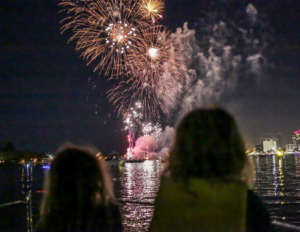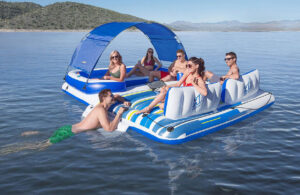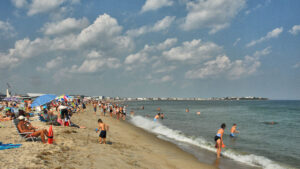As you cruise around America’s coastline, do you ever gaze at the night sky wondering what it was like to navigate a boat by the stars instead of a GPS? Do childhood fantasies of cavorting with pirates still stir in your heart and conjure up dreams of sailing with rum-guzzling scoundrels? And when veterans reminisce about shipping off to war, can you envision the sounds and sensations of traversing the seas on a colossal navy battleship? If those questions strike a chord with your nautical curiosity, then it’s time to visit our country’s maritime museums.
These treasure chests of regional history celebrate adventure on the seas and turn the ocean into a classroom. They’re more than safe havens when inclement weather or stinging sunburns drive your crew indoors. You can experience past and present life on the waterways through programs that are hands-on and interactive. At the following 10 maritime museums, do whatever floats your boat — spend the night on a 19th century tall ship, hone skills for constructing your own boat,or take an evening tour of a haunted lighthouse armed with only a flashlight.
1. Mystic Seaport Museum-Mystic, Connecticut
Sprawling across 19 acres of Mystic River shoreline, this museum has emerged as the flagship of American maritime heritage with its exceptional collection of nearly 500 historic watercraft, 1 million photographs and 2 million artifacts. The crown jewel of its fleet is the 1841 Charles W. Morgan, America’s oldest commercial vessel still afloat, which lures visitors to its deck for tales of New England’s whale-hunting past. Other major attractions: a working shipyard that rekindles the craft of building wooden boats, a planetarium that explores the wonder of celestial navigation by the moon, stars and planets, and a 19th century seafaring village that’s bustling with craftsmen, storytellers, artisans and musicians who help you skip back in time.
2. Independence Seaport Museum-Philadelphia, Pennsylvania
The current of the Delaware River swirls around a pair of vessels docked at Penn’s Landing waterfront. Cruiser Olympia, launched in 1892, is the world’s oldest floating steel warship and the only surviving navy ship of the Spanish- American War. Submarine Becuna, launched in 1944, sunk Japanese ships in the Pacific and trailed Soviet submarines with eavesdropping equipment in the Atlantic during WWII. Sailors of all ages can climb aboard and get a close look at these amazing watercraft. Be sure to save time to venture inside the museum for exhibits with rare artifacts and interactive displays on the region’s major ports. Discover how colonial patriots battled against pirates, why freedom of African- Americans changed the course of nautical history, and which watery disasters resulted in rescues or catastrophes.
3. Chesapeake Bay Maritime Museum-St. Michaels, Maryland
When the museum announces dates for its annual oyster and crab festivals, folks around the Bay mark their calendars and anticipate the celebration of scrumptious local seafood. But this is not just a place to relish a savory catch. It’s a living tribute to the region’s watermen, history, culture and environment. Located along the Miles River in the quaint harbor town of St. Michaels, the campus is comprised of 12 buildings that showcase the tradition of building workboats, carving duck decoys, processing crab meat, tonging for oysters and much more. The working boatyard, Hooper Strait Lighthouse and Point Lookout bell tower are among the attractions that welcome you to come inside and experience the Chesapeake’s nautical past. Students in grades 6 through 9 can also join the museum’s complimentary Rising Tide After-School Boatbuilding Program to learn basic boatbuilding techniques.
4. Nauticus-Norfolk, Virginia
You will marvel at its grandeur — maybe even feel a bit small — when you stroll on the deck of the battleship Wisconsin. This monument to our navy’s valor is the pride and joy of Nauticus. Even though it earned battle stars in WWII and the Korean War, don’t let your awe of this magnificent ship distract you from exploring the rest of the museum. Some exhibits target military weaponry and maritime history, and others focus on deep-sea discoveries and forces of nature. Special interactive displays on aquatic creatures, sharks and horseshoe crabs captivate young visitors. Added bonus: Watching the parade of ships in Norfolk’s harbor and experiencing the constant motion of seafaring vessels from small watercrafts to massive navy warships.
5. Ships of Sea Maritime Museum-Savannah, Georgia
It’s hard to imagine a more elegant setting to learn about the Atlantic trade between England and America in the 1700s and 1800s than at this museum. Built in 1819, the main structure is a gorgeous example of early Greek Revival architecture in the South. The mansion once belonged to William Scarbrough, who was a 19th century shipping merchant and part owner of the Savannah, the first steamboat to cross the Atlantic Ocean. Today, nine rooms of his former home present an impressive collection of model ships nestled in glass cases next to antique maritime paintings and artifacts. The sweet aroma of blooms in the garden surrounding the museum creates an ideal ambience for contemplating adventures
on the heavy seas.
6. St. Augustine Lighthouse & Maritime Museum-St. Augustine, Florida
After climbing 219 steps to the top of this historic lighthouse, you’re rewarded with a glorious view of America’s oldest seaport. While you catch your breath, you learn how an old Spanish watchtower evolved over centuries into a steady beacon of navigation for watchful sailors. Built in 1824, the lighthouse is now staffed by historians eager to tell tales of ferocious storms, epic battles and tragic shipwrecks. Exhibits filled with artifacts, model ships and treasures from archaeological dives bring those stories to life. Children’s imaginations soar in the play area equipped with a wooden boat for climbing and scavenger hunts for exploring. Dark of the Moon ghost tours dare fearless guests to investigate the site’s spooky spots by flashlight.
7. Michigan Maritime Museum-South Haven, Michigan
Even though the Atlantic and Pacific coasts claim the most nautical notoriety, this museum serves as a reminder that the Great Lakes also played a key role in American maritime history. Inside five exhibition buildings, you discover a variety of displays on boat building, sea culture and shipwrecks. But just add water outside, and you can board a noteworthy fleet of watercrafts ranging from Coast Guard rescue boats to fishing tugs and the replica tall ship Friends Good Will, a merchant vessel converted to troop transport ship in the War of 1812. This summer’s new exhibit, Lake Michigan’s Call to Duty, shows how this region mobilized for World War II after Japan attacked Pearl Harbor.
8. Texas Seaport Museum-Galveston, Texas
Tucked away in the Gulf of Mexico on the barrier island of Galveston lies a hidden gem of regional nautical history. Strolling through its halls reveals the stories of ships that defended America’s southern coastline and delivered hopeful immigrants to it shores. The museum’s centerpiece is the 1877 tall ship Elissa, which is not a replica but the actual vessel that was rescued from a scrap yard and painstakingly restored. A new exhibit uses model ships, artifacts and paintings to tell the tale of the Texas Navy’s maritime adventures and fight for independence from foreign powers.
9. Santa Barbara Maritime Museum-Santa Barbara, California
California’s coastline is teeming with watercraft from surfboards to battleships. This museum, dedicated to preserving the region’s maritime heritage, is located in lovely Santa Barbara Harbor and is overflowing with interactive and innovative displays. Visitors of all ages enjoy exhibits on underwater photography, female lighthouse keepers, shipwrecks, Coast Guard rescues, commercial fishing, Navy seaplanes, the history of surfing and more. Lectures and educational programs target new nautical themes and marine science. A special project arranges sleepovers on the tall ship Spirit of Dana Point so students can experience life as a sailor in the 1830s.
10. Columbia River Maritime Museum-Astoria, Oregon
Unpredictable waves, raging storms and wild natural forces make the intersection of the Columbia River and Pacific Ocean one of the most treacherous passages on the West Coast. Near this location awaits a museum that houses the leading collection of Pacific Northwest maritime artifacts in the country and a renowned research library. Its exhibits cover a gamut of nautical topics ranging from Coast Guard rescue ships to pirate treasures and seafaring commerce. The floating lightship Columbia invites you to venture on board and experience the challenges of using bright lamps and thunderous horns to alert seafaring vessels of danger lurking in the waters.





